L5: Lac operon
1/38
There's no tags or description
Looks like no tags are added yet.
Name | Mastery | Learn | Test | Matching | Spaced |
|---|
No study sessions yet.
39 Terms
Bacteria such as E. Coli have the ability to ________ lactose and cleave it into ________ and _________
hydrolyse lactose, cleave it into galactose and glucose
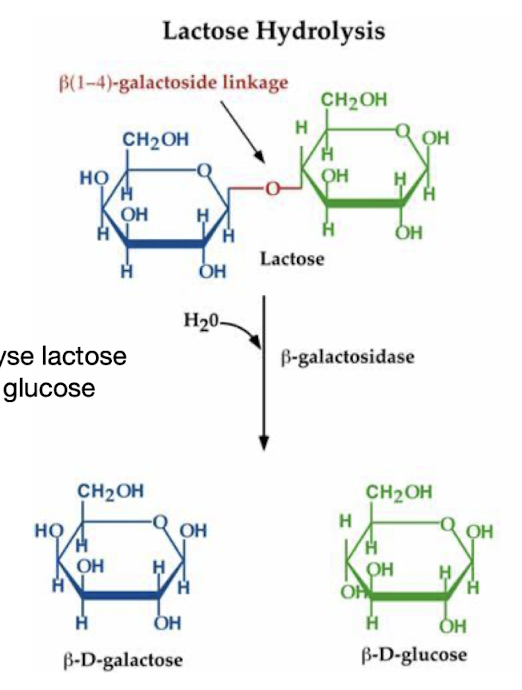
lacZ is the ___ LacZ is the _____
lacZ is the gene
LacZ is the protein
that encodes for beta-galactosidase, an enzyme that hydrolyzes lactose.
what is the layout of the lac operon?
The lac operon is composed of three structural genes: lacZ, lacY, and lacA, along with a promoter and operator region. It regulates the metabolism of lactose in bacteria.
lacZ encodes for β-galactosidase
lacY encodes for permease
lacA encodes for transacetylase
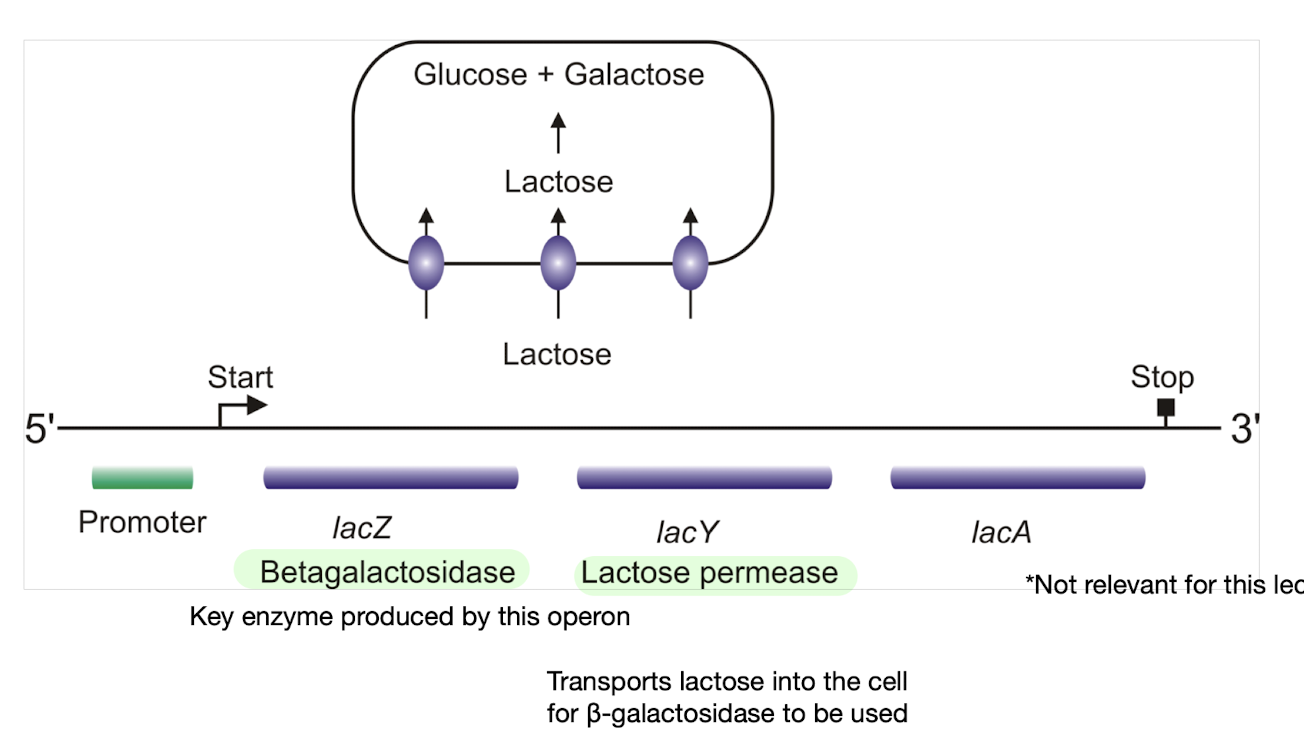
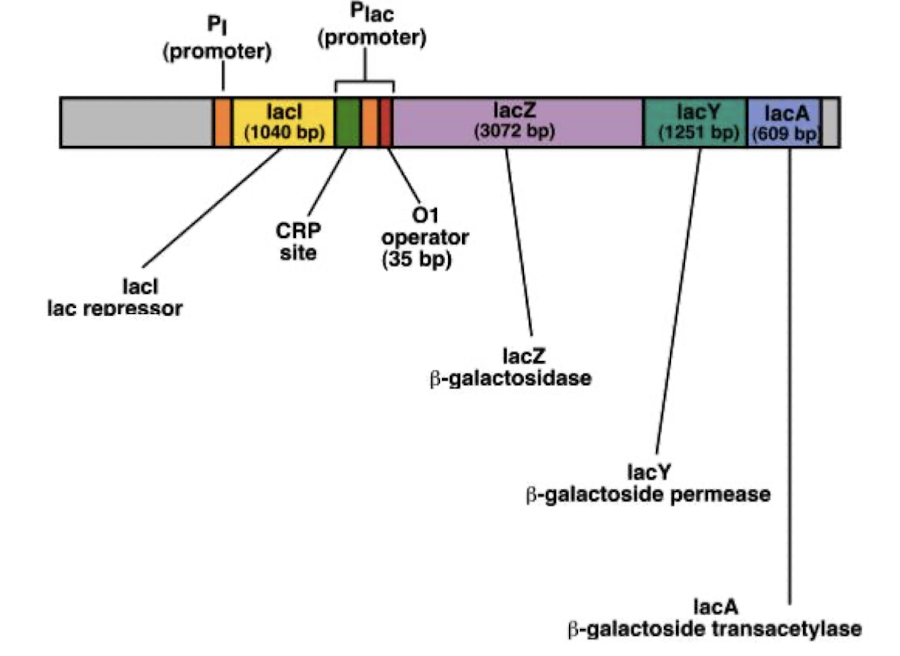
What is the role of permease?
Permease facilitates the transport of lactose across the bacterial cell membrane, enabling its uptake for metabolism so β-galactosidase can cleave lactose
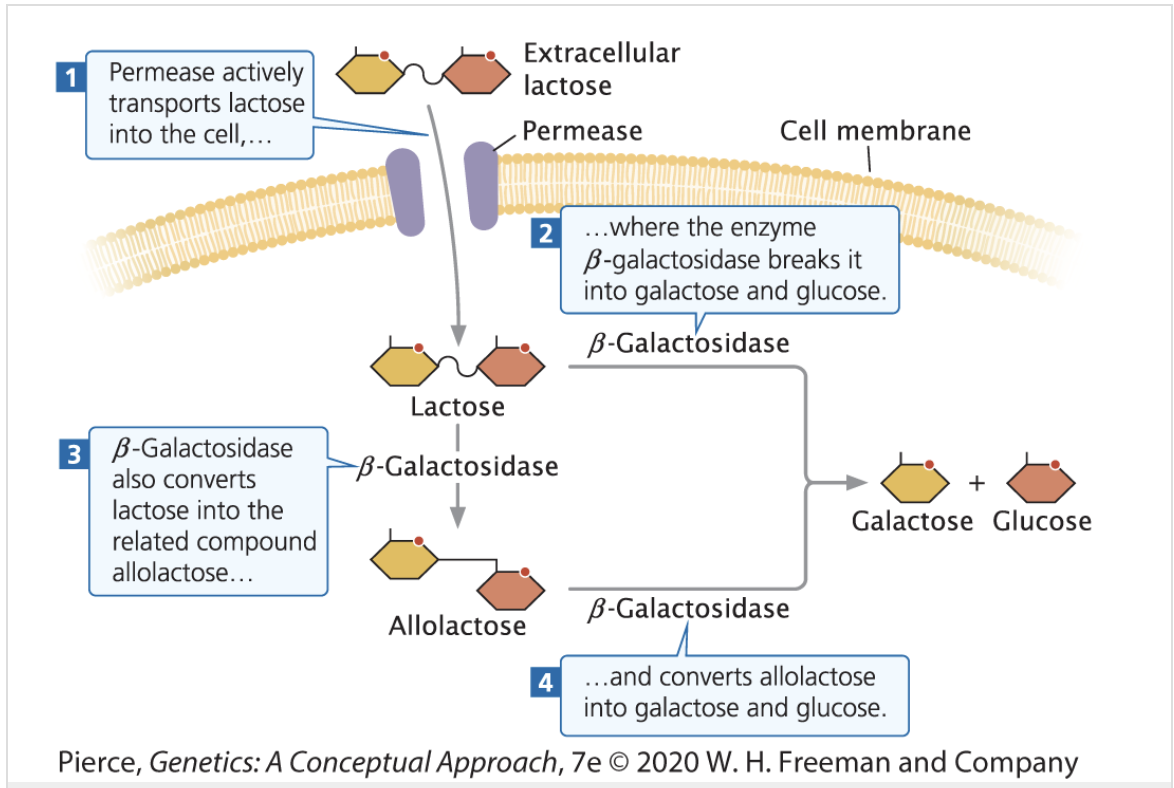
What do bacteria have to consider in regards to expressing the lac operon?
Bacteria prefers glucose as an energy source 1st as it doesn’t have to be cleaved by enzymes like β-galactosidase in the case of lactose to be used by the cell
After rapid growth when glucose is scarce, bacteria switch to lactose utilization
How can we illustrate the growth phase of E.Coli in glucose and lactose?
Using a growth curve that shows exponential growth on glucose, followed by a lag phase followed by induction of BG and subsequent growth on lactose.
Diauxic growth is when bacteria exhibit two distinct phases of growth, utilizing glucose first and then lactose.
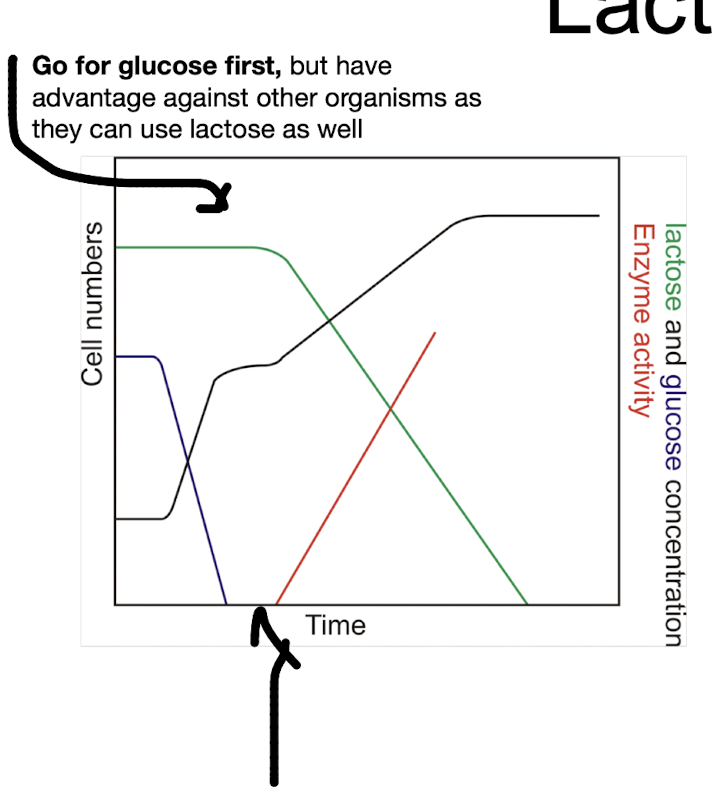
Catabolite repression regulates metabolism by….
Metabolism of one substrate suppresses the induction of enzymes involved in the metabolism of the second substrate
It controls the use of carbon sources i.e glucose when more than one is present.
What is a benefit of catabolite repression for a bacterial cell?
Genes for the synthesis of flagella are controlled by catabolite repression so if bacteria have a good carbon source available, there is NO need to swim around in search of nutrients.
As glucose is the best energy source, catabolite repression prevents expression of most other catabolic operons as long as glucose is present
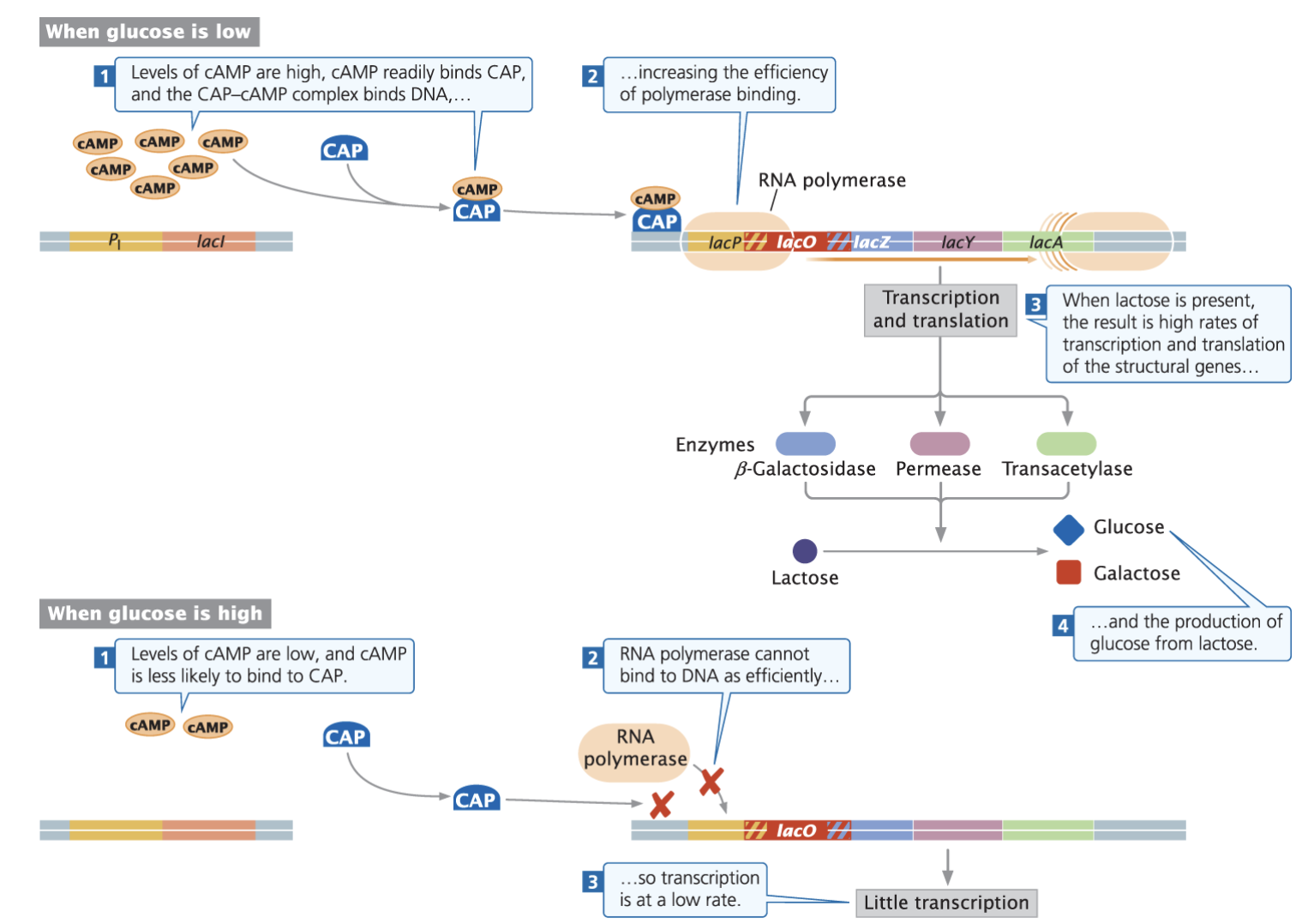
lacI is known as a _______ as it consists of a _______ protein that stops ______ from binding to the _______
classical repressor, DNA binding protein that stops RNA polymerase from binding to the promoter
*WHEN NO LACTOSE is present, repression occurs
Protein forms a tetramer binds to the operator DNA sequence, blocking transcription of downstream genes
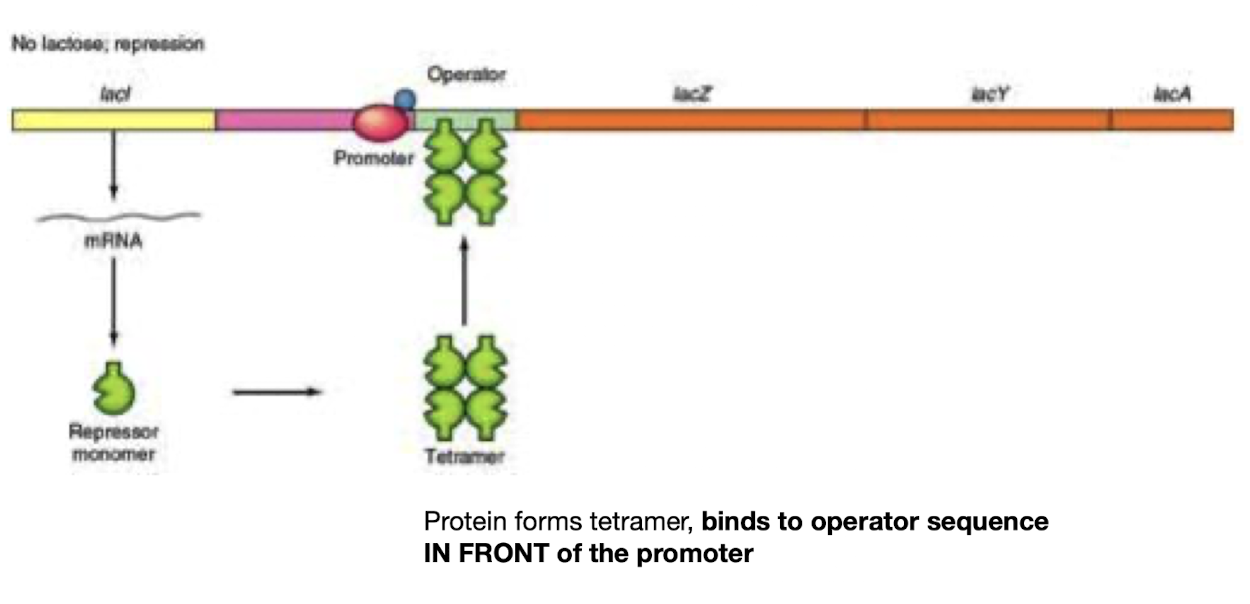
what is the inducer?
Allolactose, a lactose metabolite that binds to the lac repressor, causing LacI (repressor) to release from the operator region and allowing transcription of the lac operon.
acts as the allosteric effector by binding to the inducer-binding site, reducing LacI’s affinity for the operator significantly
Occurs in absence of lactose where very low levels of BG by lacZ are produced

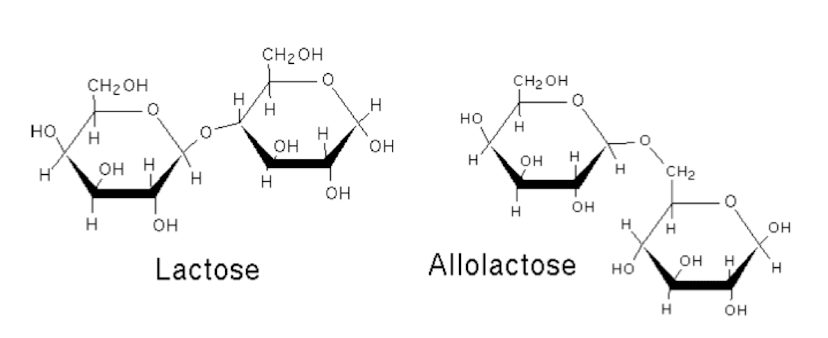
In the absence of lactose….
LacI (repressor) binds to lac promoter inhibiting RNAP binding and thus transcription → low BG levels
In the presence of lactose…..
(*in presence of lactose) Allolactose binds to LacI and releases it from the operator, allowing RNAP to bind and inducing transcription
What is meant by a weak promoter?
A weak promoter is a DNA sequence that facilitates less efficient binding of RNAP, leading to reduced transcription rates compared to stronger promoters
Why is the lac promoter seen as weak?
−35 and −10 sequences vary from the optimal consensus recognises by the σ⁷⁰ of RNA
Spacing is slightly suboptimal
Lacks upstream enhancing elements—resulting in poor RNAP binding and low baseline transcription.
Even in the absence of LacI (repressor) ,the lac promoter has lower affinity for RNAP, leading to reduced transcription efficacy.

what is the activator protein required to aid transcription of the lac operon, & what are some key features of the molecule?
CRP - Cyclic AMP receptor protein (same as CAP catabolite gene activator protein)
Allosteric protein which binds to DNA ONLY if it has 1st bound a small molecule called cyclic adenosine monophosphate (cAMP)
CRP binds as a dimer
Regulatory nucleotide that enhances RNAP binding to the lac promoter when glucose levels are low.
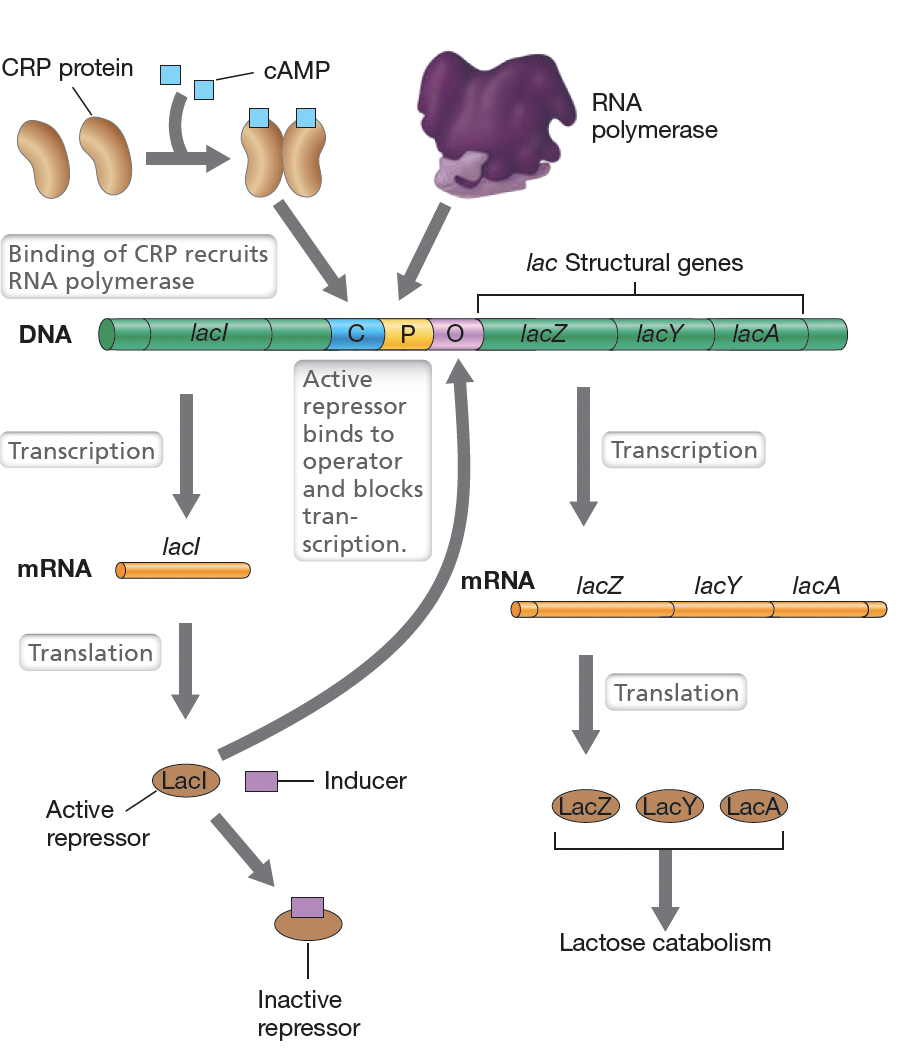
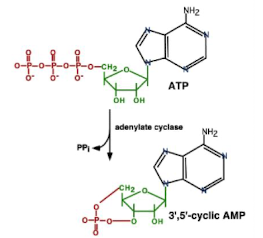
cAMP is produced from ATP by __________
Adenylate cyclase
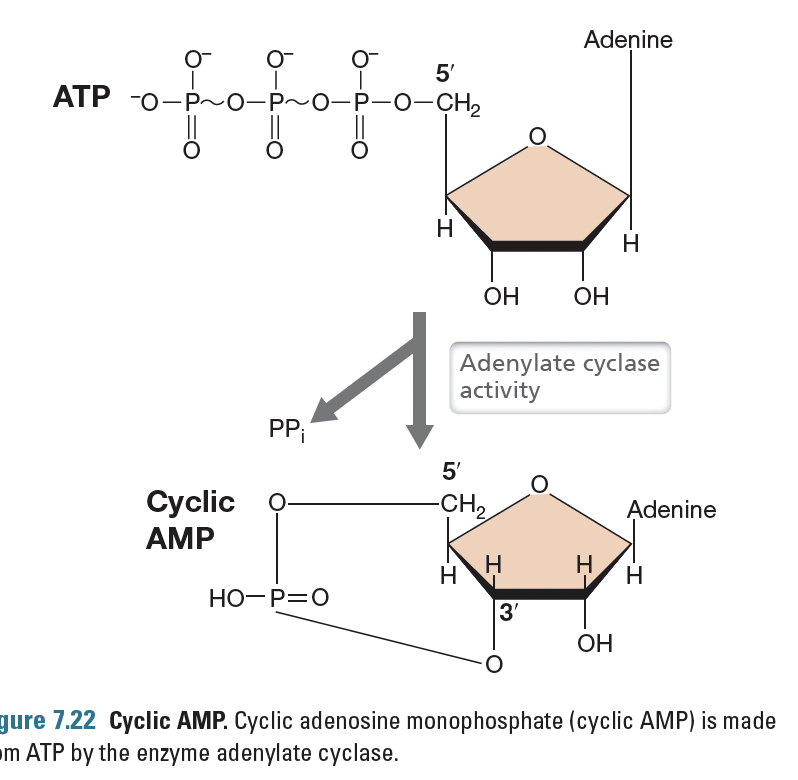
Glucose inhibits cAMP synthesis, True or False?
True, as well as transport inhibition out of the cell.
When glucose enters the cell, the cyclic AMP level is lowered
CRP (activator) cannot bind DNA, and RNAP fails to bind to the promoters of operons subject to catabolite repression.
Thus, catabolite repression is an indirect result of the presence of a better energy source (glucose); the direct cause of catabolite repression is a low level of cyclic AMP vs a high level when glucose is absent
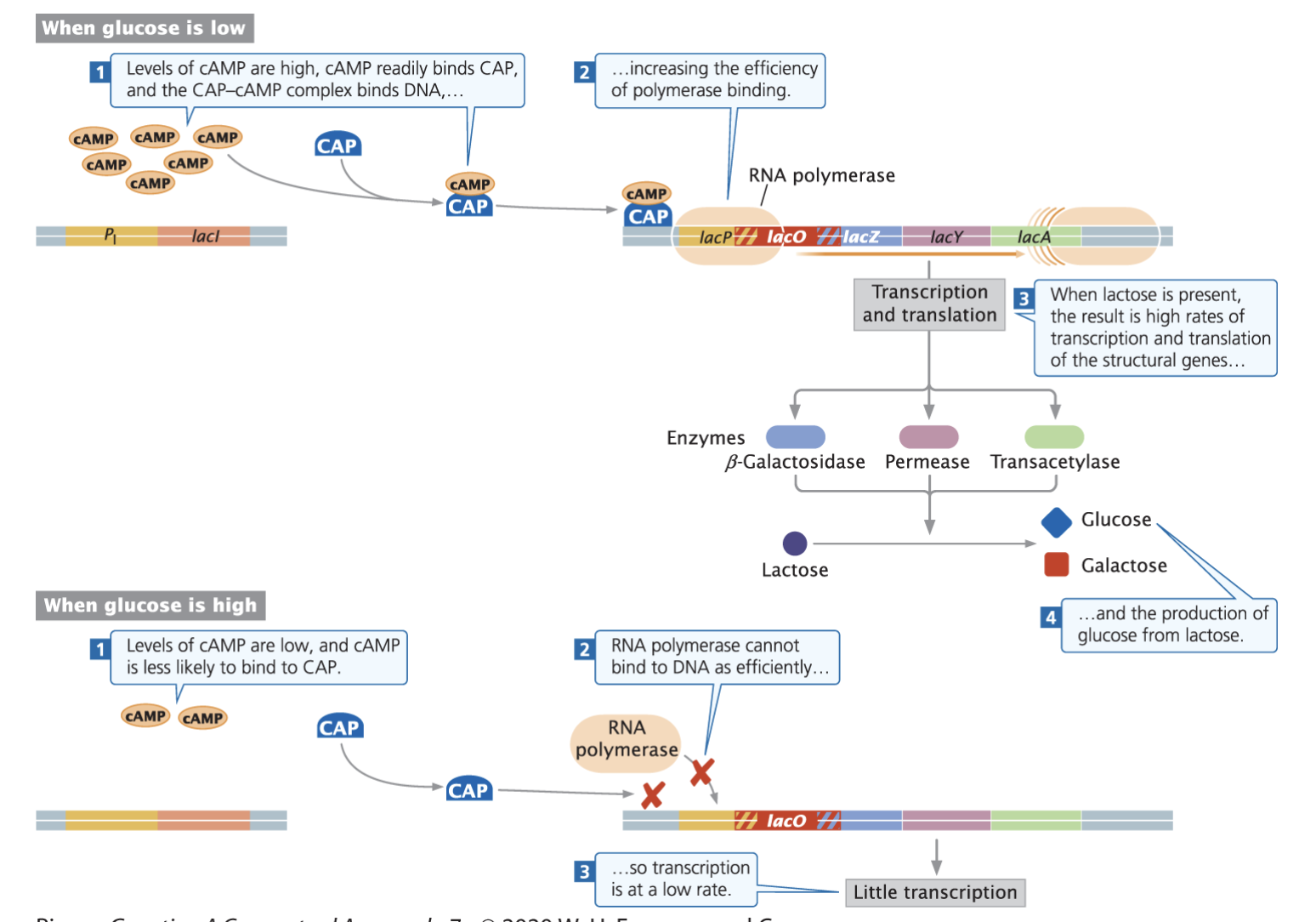
Where is the CRP binding site found?

Located upstream of the lac promoter region.
It is essential for the recruitment of RNAP and the initiation of transcription when cAMP levels are high.
CRP-cAMP binds to this binding site in the absence of glucose, interacts with the CTD of the ⍺ subunit of RNAP
Creates a distortion of the helix which may help in open complex formation
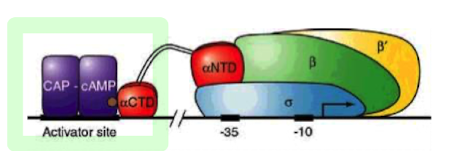
CRP-cAMP bound to DNA causes _________
distorted DNA which may open more, enhances the binding of RNAP to the promoter, facilitating the initiation of transcription
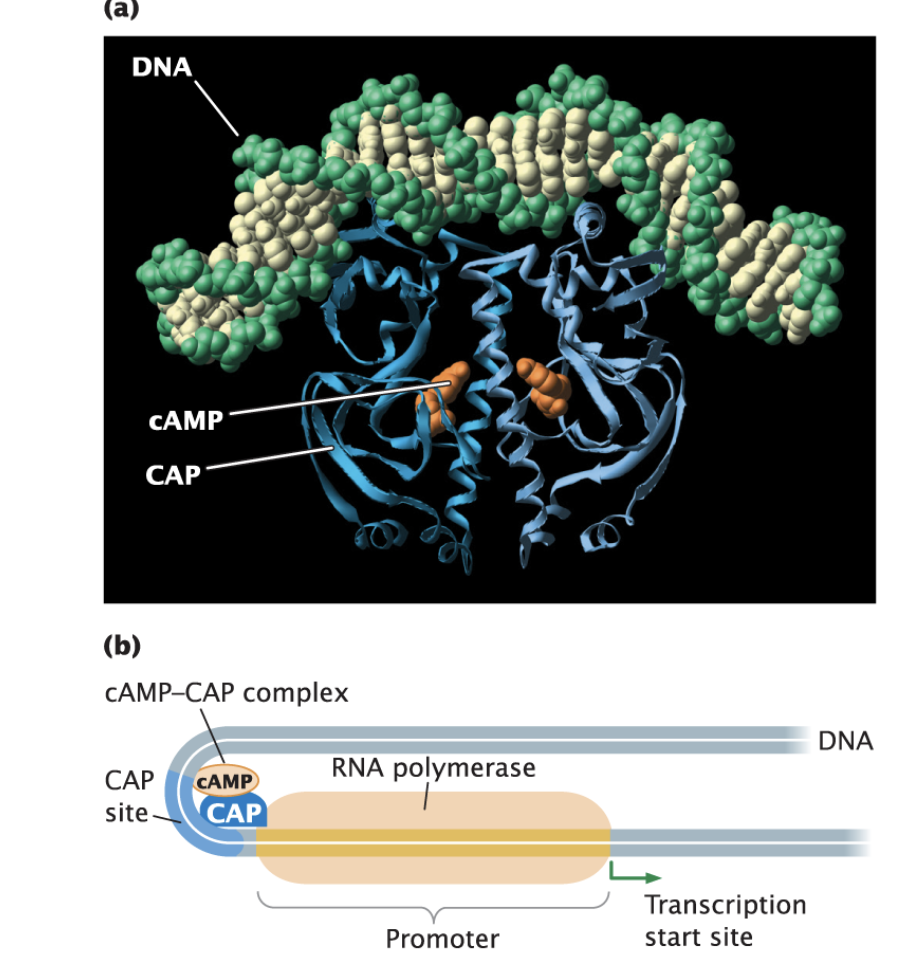
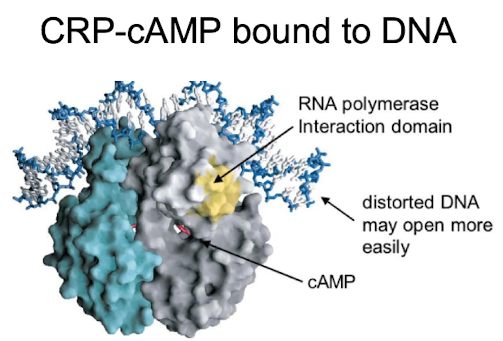
Lactose present →
Allolactose (inducer) binds to the repressor protein LacI, causing it to change shape and release from the operator, allowing transcription of the genes needed for lactose metabolism.
Allolactose produced →
LacI released from repressor site of promoter
*not sufficient unless no glucose is present and CRP-cAMP is bound
No glucose is present →
cAMP levels rise
cAMP levels rise →
CRP-cAMP binds to promoter to induce transcription
What are the two key signalling molecules used by bacteria to know when to induce/ repress the lac operon?
Allolactose and cAMP are the two key signaling molecules used by bacteria to regulate the lac operon induction and repression.
How are levels of cAMP and allolactose controlled so that bacteria can choose which substrate to use?
Uptake systems i.e LacY + glucose transport mechanisms control the levels of cAMP and allolactose in response to the presence or absence of glucose.
What type of protein transport system is LacY?
LacY is a symporter that facilitates the transport of lactose into the bacterial cell while simultaneously transporting H+
This system allows for the uptake of lactose when available.
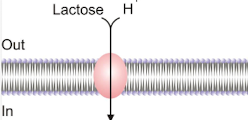
What happens to glucose during transport?
Glucose is phosphorylated and converted to glucose-6-phosphate (by hexokinase)
Preventing it from diffusing back out of the cell due to the negative charge of the phosphorylated sugar, which helps regulate sugar metabolism.
This phosphate group travels through a phosphate cascade

What is the phosphorylation cascade?
A series of enzymatic reactions where a phosphate group is transferred from one molecule to another, often in a signalling pathway to amplify a cellular response.
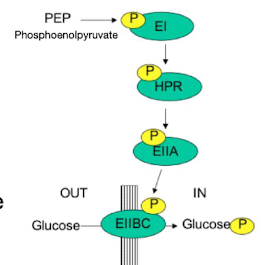
The level of glucose in media affects the __________ of the proteins
phosphorylation
HIGH glucose means most of the glucose specific enzyme ____ will have donated its phosphate to ________
EIIA → EIIBC
So most EIIA is the unphosphorylated in HIGH glucose
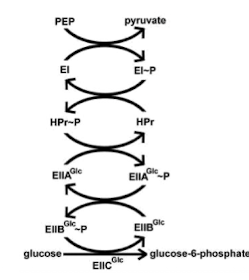
What is the significance of unphosphorylated EIIA?
It binds to and inhibits the action of lactose permease
*Thus ratio of EIIA and EIIA-P affects Lactose uptake
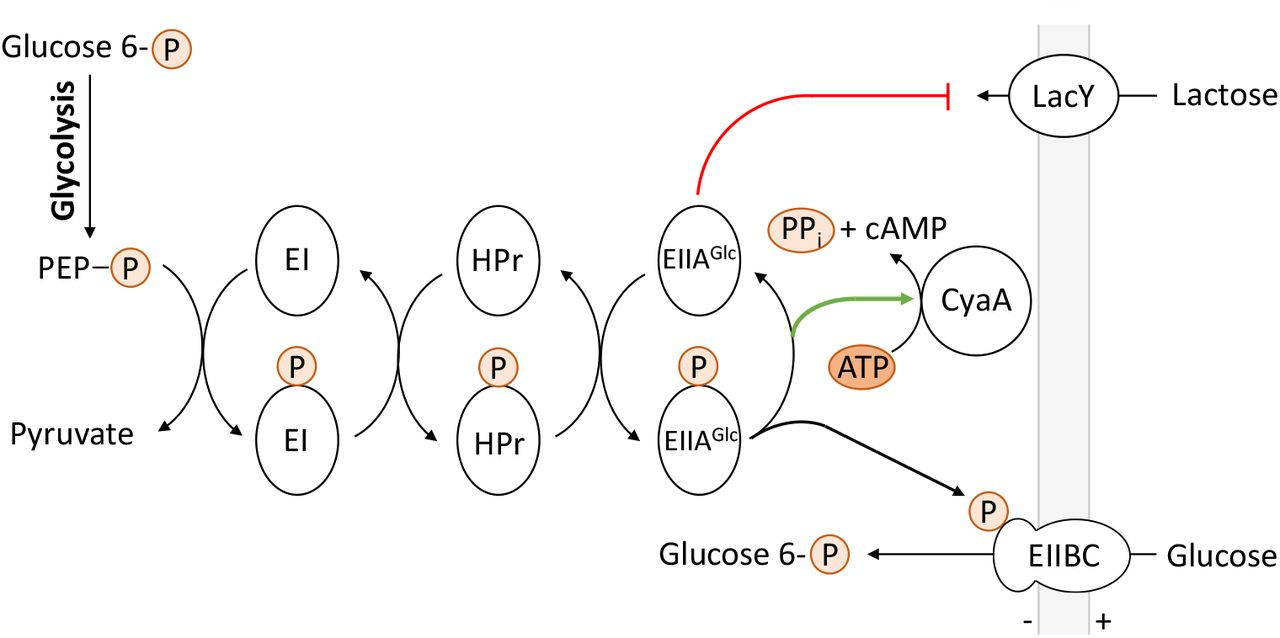
What is the effect of glucose on lactose uptake?
High glucose levels inhibit lactose uptake due to unphosphorylated EIIA binding to lacpermease
Thus allolactose can’t be produced so no inducer to remove LacI, helps explain why glucose is used 1st
How does E. coli know when all the glucose is gone?
E. coli detects glucose depletion through changes in EIIA phosphorylation i.e when glucose is absent, EIIA is more likely to be phosphorylated:
EIIA-P activates Adenylate cyclase which increases cAMP levels, allowing CRP-cAMP to bind to lac promoter (activation)
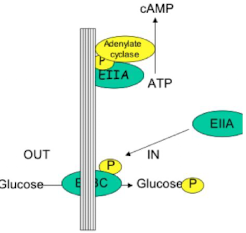
Low glucose means EIIA-P is _______ and EIIA is ________
increased, decreased
(at promoter) Transcription repressor →
LacI
(at promoter) Transcription activator →
CRP-cAMP (cAMP Receptor Protein)
(beyond promoter) Inducer Exclusion →
EIIA binds to LacY and prevents lactose → allolactose from entering the cell.
(beyond promoter) cAMP production →
EIIA-P activates Adenylate cyclase which increases cAMP levels
Why is CRP known as a global regulator?
Regulates the expression of numerous operons and genes across various metabolic pathways in response to cellular levels of cAMP.
Many other operons can be controlled by CRP in conjunction with other regulatory proteins